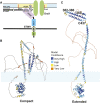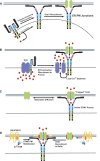Regulatory mechanisms controlling store-operated calcium entry
- PMID: 38169682
- PMCID: PMC10758431
- DOI: 10.3389/fphys.2023.1330259
Regulatory mechanisms controlling store-operated calcium entry
Abstract
Calcium influx through plasma membrane ion channels is crucial for many events in cellular physiology. Cell surface stimuli lead to the production of inositol 1,4,5-trisphosphate (IP3), which binds to IP3 receptors (IP3R) in the endoplasmic reticulum (ER) to release calcium pools from the ER lumen. This leads to the depletion of ER calcium pools, which has been termed store depletion. Store depletion leads to the dissociation of calcium ions from the EF-hand motif of the ER calcium sensor Stromal Interaction Molecule 1 (STIM1). This leads to a conformational change in STIM1, which helps it to interact with the plasma membrane (PM) at ER:PM junctions. At these ER:PM junctions, STIM1 binds to and activates a calcium channel known as Orai1 to form calcium release-activated calcium (CRAC) channels. Activation of Orai1 leads to calcium influx, known as store-operated calcium entry (SOCE). In addition to Orai1 and STIM1, the homologs of Orai1 and STIM1, such as Orai2/3 and STIM2, also play a crucial role in calcium homeostasis. The influx of calcium through the Orai channel activates a calcium current that has been termed the CRAC current. CRAC channels form multimers and cluster together in large macromolecular assemblies termed "puncta". How CRAC channels form puncta has been contentious since their discovery. In this review, we will outline the history of SOCE, the molecular players involved in this process, as well as the models that have been proposed to explain this critical mechanism in cellular physiology.
Keywords: DHHC21; Orai1; S-acylation; STIM1; calcium; immune diseases; store-operated calcium entry.
Copyright © 2023 Kodakandla, Akimzhanov and Boehning.
Conflict of interest statement
The authors declare that the research was conducted in the absence of any commercial or financial relationships that could be construed as a potential conflict of interest.
Figures




Update of
-
Regulatory mechanisms controlling store-operated calcium entry.ArXiv [Preprint]. 2023 Dec 7:arXiv:2309.06907v3. ArXiv. 2023. Update in: Front Physiol. 2023 Dec 19;14:1330259. doi: 10.3389/fphys.2023.1330259 PMID: 37744466 Free PMC article. Updated. Preprint.
Similar articles
-
Regulatory mechanisms controlling store-operated calcium entry.ArXiv [Preprint]. 2023 Dec 7:arXiv:2309.06907v3. ArXiv. 2023. Update in: Front Physiol. 2023 Dec 19;14:1330259. doi: 10.3389/fphys.2023.1330259 PMID: 37744466 Free PMC article. Updated. Preprint.
-
Store-Independent Orai Channels Regulated by STIM.In: Kozak JA, Putney JW Jr, editors. Calcium Entry Channels in Non-Excitable Cells. Boca Raton (FL): CRC Press/Taylor & Francis; 2018. Chapter 11. In: Kozak JA, Putney JW Jr, editors. Calcium Entry Channels in Non-Excitable Cells. Boca Raton (FL): CRC Press/Taylor & Francis; 2018. Chapter 11. PMID: 30299650 Free Books & Documents. Review.
-
Modulation of Orai1 and STIM1 by Cellular Factors.In: Kozak JA, Putney JW Jr, editors. Calcium Entry Channels in Non-Excitable Cells. Boca Raton (FL): CRC Press/Taylor & Francis; 2018. Chapter 4. In: Kozak JA, Putney JW Jr, editors. Calcium Entry Channels in Non-Excitable Cells. Boca Raton (FL): CRC Press/Taylor & Francis; 2018. Chapter 4. PMID: 30299655 Free Books & Documents. Review.
-
Studies of Structure-Function and Subunit Composition of Orai/STIM Channel.In: Kozak JA, Putney JW Jr, editors. Calcium Entry Channels in Non-Excitable Cells. Boca Raton (FL): CRC Press/Taylor & Francis; 2018. Chapter 2. In: Kozak JA, Putney JW Jr, editors. Calcium Entry Channels in Non-Excitable Cells. Boca Raton (FL): CRC Press/Taylor & Francis; 2018. Chapter 2. PMID: 30299645 Free Books & Documents. Review.
-
Regulation and Role of Store-Operated Ca2+ Entry in Cellular Proliferation.In: Kozak JA, Putney JW Jr, editors. Calcium Entry Channels in Non-Excitable Cells. Boca Raton (FL): CRC Press/Taylor & Francis; 2018. Chapter 12. In: Kozak JA, Putney JW Jr, editors. Calcium Entry Channels in Non-Excitable Cells. Boca Raton (FL): CRC Press/Taylor & Francis; 2018. Chapter 12. PMID: 30299656 Free Books & Documents. Review.
Cited by
-
Diverse pathways in GPCR-mediated activation of Ca2+ mobilization in HEK293 cells.J Biol Chem. 2024 Nov;300(11):107882. doi: 10.1016/j.jbc.2024.107882. Epub 2024 Oct 10. J Biol Chem. 2024. PMID: 39395798 Free PMC article.
-
Impact of Metal Ions on Cellular Functions: A Focus on Mesenchymal Stem/Stromal Cell Differentiation.Int J Mol Sci. 2024 Sep 20;25(18):10127. doi: 10.3390/ijms251810127. Int J Mol Sci. 2024. PMID: 39337612 Free PMC article. Review.
-
Unlocking the therapeutic potential of P2X7 receptor: a comprehensive review of its role in neurodegenerative disorders.Front Pharmacol. 2024 Jul 30;15:1450704. doi: 10.3389/fphar.2024.1450704. eCollection 2024. Front Pharmacol. 2024. PMID: 39139642 Free PMC article. Review.
-
Putative retina metal/metalloid-binding proteins: molecular functions, biological processes and retina disease associations.Metallomics. 2024 Oct 4;16(10):mfae045. doi: 10.1093/mtomcs/mfae045. Metallomics. 2024. PMID: 39322243 Free PMC article.
References
-
- Alavizargar A., Berti C., Ejtehadi M. R., Furini S. (2018). Molecular dynamics simulations of orai reveal how the third transmembrane segment contributes to hydration and Ca(2+) selectivity in calcium release-activated calcium channels. J. Phys. Chem. B 122, 4407–4417. 10.1021/acs.jpcb.7b12453 - DOI - PubMed
Publication types
Grants and funding
LinkOut - more resources
Full Text Sources

